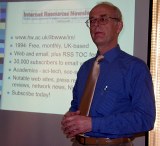 I’m still following the social media for scientists trail and asked my good friend Roddy MacLeod of Heriot-Watt University, Edinburgh, who runs the Internet Resources Newsletter whether he had any thoughts on gathering up social media resources and scientists into a directory or other online resource. It would be useful, for instance, to know which scientists are on Twitter, who is using Ning sites and who can be poked, with a testtube, on Facebook.
I’m still following the social media for scientists trail and asked my good friend Roddy MacLeod of Heriot-Watt University, Edinburgh, who runs the Internet Resources Newsletter whether he had any thoughts on gathering up social media resources and scientists into a directory or other online resource. It would be useful, for instance, to know which scientists are on Twitter, who is using Ning sites and who can be poked, with a testtube, on Facebook.
I asked MacLeod what he thought of the idea of collating all the scientists on Twitter, Facebook, LinkedIn etc. “The question maybe is whether all the scientists would like to be gathered up. After all, it’s the individual who is in control of his/her own environment in these general social networks, and maybe that’s the way it should be.”
“I did a wee post on some social networking services on the spineless blog, but mostly leave that to SciTechNet and Brian Kelly et al,” he told me. “One thing I reckon is that as social networking sites like IET Discover and 2collab, and others multiply, it’s going to get more difficult for librarians. They can’t be expected to join and participate in all the possible specialised social networks, unless they specialise in a very particular subject, so they’ll end up missing a lot of potentially useful stuff. “There are so many, I can barely keep up,” he confessed, “Some interoperability between them would be great, because otherwise you have to spend time creating a brand-new profile for each one.”
He adds, that we [information scientists and librarians] are in a similar situation as they were with the burgeoning spread of trade journals, but at least librarians could scan those occasionally, so keeping up was easier. Many of the thousands of trade journals are free.
MacLeod echoes a commentator in my previous SM post regarding financing of these sites: “I reckon that only the well-supported social networking services will survive (those backed up by large professional societies or major publishers),” he told me, “Some of the smaller ones may end up like those discussion forums on some sites where no-one actually discusses anything.” There already are plenty of cob-webs on the net. “Yes, there are the very general all-subject ones, the well-supported general ones such as IET Discover and 2collab, some niche ones which are likely to survive,” adds MacLeod, “and some chancer ones that are trying to jump on the bandwagon. This means some wasted effort as we wait to see which ones will take off and survive, but there is no other way.”
 MacLeod will soon be busy promoting ticTOCs, which will potentially help all researchers, including those unaware of RSS newsfeeds or who don’t care for that technology and keen RSS aggregators alike. “ticTOCs will serve both types of user in different ways allowing them to keep up-to-date with the research literature.”
MacLeod will soon be busy promoting ticTOCs, which will potentially help all researchers, including those unaware of RSS newsfeeds or who don’t care for that technology and keen RSS aggregators alike. “ticTOCs will serve both types of user in different ways allowing them to keep up-to-date with the research literature.”
To use ticTOCs as a current awareness service, you don’t need to know anything at all about RSS. ticTOCs ingests RSS feeds behind the scenes, but it’s perfectly possible, using ticTOCs to find, display, expand and then save (to the MyTOCs feature in ticTOCs) tables of contents to keep current without any mention or knowledge of RSS. “To me, this is the main use of ticTOCs because,” adds MacLeod, “as a Forrester report recently pointed out many people don’t understand/use/can’t be bothered with RSS. However, for the minority who are happy to use RSS, ticTOCs can be used as a tool to find relevant table of contents feeds, and then export them to the person’s favourite feed reader.”
The important point about RSS and TOCs is described in Lisa Rogers’ article in FUMSI. What librarians and every researcher needs is RSS feeds for journal TOCs. Moreover, publishers must produce TOC feeds in a standardised way, says MacLeod. This will allow both individuals, and services such as ticTOCs and others (see 6 mentioned in IRN) to better utilise feeds, and this in turn will help get current journals better exploited. “What ticTOCs has found is that publishers currently don’t produce journal TOC RSS feeds in a standard way,” MacLeod says, “they insert all sorts of things in various fields, they put the authors in various fields, they often don’t include abstracts, often don’t include the DOI, often don’t cite authors in a standard way, etc.
Rogers’ article goes some way to explaining what publishers should do, and CrossRef will be coming out with more Recommendations for publishers with respect to tables of contents RSS feeds in the future. “This is also very important for publishers because of the increasing emphasis on papers being deposited in Institutional Repositories after 6 months of being published,” adds MacLeod, “So, the publishers need to exploit their current content as soon as possible after publication as possible.”
 Batteries are included (unfortunately) – A chemical cocktail of toxic gases is released when you burn alkaline batteries, according to the latest research from Spain. The investigating team highlights the issue with respect to municipal waste incineration, which is used as an alternative to landfill and suggests that recycling is perhaps the only environmentally viable alternative.
Batteries are included (unfortunately) – A chemical cocktail of toxic gases is released when you burn alkaline batteries, according to the latest research from Spain. The investigating team highlights the issue with respect to municipal waste incineration, which is used as an alternative to landfill and suggests that recycling is perhaps the only environmentally viable alternative. This week, The Alchemist is digging in the dirt to find out about the carbon cycle and climate change, taking his
This week, The Alchemist is digging in the dirt to find out about the carbon cycle and climate change, taking his  A new(ish) website has launched that aims to provide unbiased patient-generated data on the benefits of 7000 prescription medications and their side-effects.
A new(ish) website has launched that aims to provide unbiased patient-generated data on the benefits of 7000 prescription medications and their side-effects. I’m still following the
I’m still following the  MacLeod will soon be busy promoting
MacLeod will soon be busy promoting  A while back, I visited the Bushmills whiskey distillery (it was my second visit in as many decades) always a pleasure, especially the tasting panel at the end of the tour just before you spend all your money on, ahem, souvenirs.
A while back, I visited the Bushmills whiskey distillery (it was my second visit in as many decades) always a pleasure, especially the tasting panel at the end of the tour just before you spend all your money on, ahem, souvenirs. It’s that time of year again. The shops have been full of Xmas
It’s that time of year again. The shops have been full of Xmas  Dioxins Before Swine – Irish pork is off the menu, according to the BBC.
Dioxins Before Swine – Irish pork is off the menu, according to the BBC. If you ever thought genetics was only about disease, then check out the popular SNPs list on
If you ever thought genetics was only about disease, then check out the popular SNPs list on